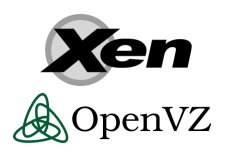A Continuing Work in Progress: The State of Linux 2006
Virtually Victorious
Figure 11: AMD/Intel next-generation server cores (images Copyright 2006 AMD for Opteron chip views and logo, 2005 Intel Corporation for Xeon chip views)
Linux achieved yet another major milestone in 2006 in the server virtualization (SV) market space, with a few prominent (though entirely separate) software initiatives. Business customer demands for increases in virtualized performance have prompted both hardware vendors and software developers to make a collaborative effort to tightly integrate hardware-level virtualization features and software application interfaces. Both AMD and Intel provide in-kernel virtualization schemes that, when coupled with a well-designed application architecture, can deliver bare-metal performance.
EMC's VMware product line encompasses a wide variety of virtualization solutions, from the home desktop to the enterprise server. VMware has already established street credibility in the SV marketplace as a turnkey solutions provider catering to tighter Linux-Windows integration and interoperability. EMC recently went to great lengths to market the latest revolution of workstation and server applications, and even openly released free evaluation copies for both Windows and Linux platforms. This small token of generosity is an excellent opportunity for proponents of OSS to push Linux into predominantly Windows-based environments, or wherever Linux appears to promise a better return on hardware investment or licensing costs.
Figure 12: Xen, OpenVZ, VMware icons
Perhaps even more momentous than the EMC movement are the Xen and OpenVZ SV OSS initiatives, both of which boast tighter integration between the Linux platform and hardware-based virtualization features found in the latest AMD and Intel server offerings. Two prominent Linux distributors, Red Hat and Novell (SUSE), mutually announced their plans to adopt Xen SV software into their forthcoming mainstream enterprise distributions, due out later this year. Xen clearly has established an advantageous position: as a pervasive part of the mainstream product lines of both companies, Xen can quickly gain exposure to their combined subscriber bases.
SWsoft's OpenVZ SV software also provides an OSS solution for the Linux platform, and the company is urging its integration directly into the mainstream Linux kernel. One of the competitive advantages that OpenVZ has over similar projects, is that OpenVZ is derived from a well-regarded commercial application with a proven track history made by the same publisher, called Virtuozzo. Whether or not OpenVZ takes foothold as a mainstream component remains to be seen, but the simple fact that Linux has a huge spotlight in the SV marketplace plays a pivotal role in shaping its future for all parties involved.
Microsoft also plays a role in the virtualization market, and promises to deliver its upcoming Vista platform with integrated virtualization capability. Currently, support for Red Hat and Novell distributions is available in its Virtual Server 2005 (Release 2) product line, and it works for customers that use VS 2005 alongside Linux installations. By the same token, Microsoft's offering faces its biggest threat from VMware, which installs and runs on both Linux and Windows servers.
Get Tom's Hardware's best news and in-depth reviews, straight to your inbox.
Current page: Virtually Victorious
Prev Page Linux On The Server Really Sings Next Page Linux Goes Mobile, But More On Phones Than Notebook PCsEd Tittel is a long-time IT writer, researcher and consultant, and occasional contributor to Tom’s Hardware. A Windows Insider MVP since 2018, he likes to cover OS-related driver, troubleshooting, and security topics.


